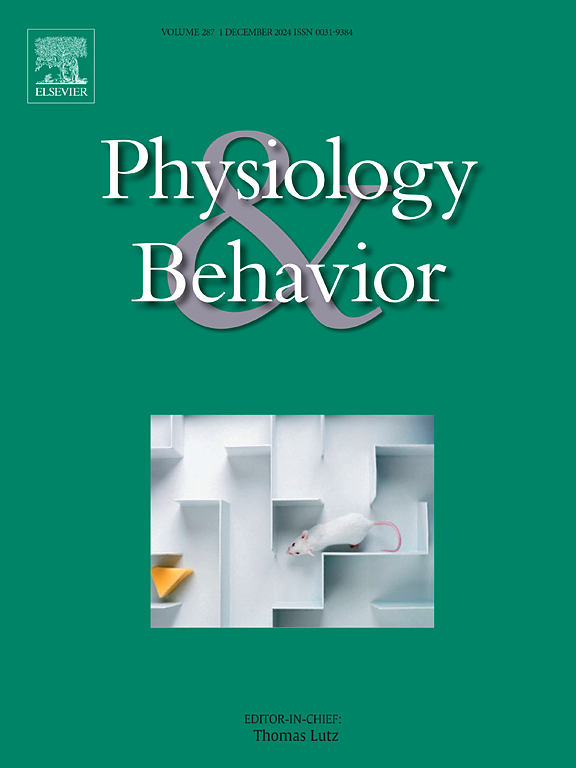肥胖会改变雄性小鼠对恒定光照的昼夜节律和行为反应
IF 2.4
3区 医学
Q2 BEHAVIORAL SCIENCES
引用次数: 0
摘要
众所周知,夜间暴露在人造光下会扰乱生物钟,从而导致情绪和新陈代谢受损。代谢激素的分泌受昼夜节律起搏器的调节,最近的研究表明,胰岛素和瘦素等激素也会直接影响行为结果和昼夜节律。反过来,肥胖本身也会调节昼夜节律并改变情绪。本研究调查了两种肥胖模型中持续光照对行为和代谢的影响,一种是瘦素无效突变体(OB),另一种是通过高脂饮食诱发的肥胖。在这两项实验中,小鼠都被置于标准的光暗循环(LD)或恒定光照(LL)中,并持续监测它们的昼夜节律。在各自的光照条件下暴露10周后,所有小鼠都要接受开放场地试验,以评估它们的探索行为。此外,还测量了它们的代谢激素水平和炎症水平。从行为上看,与两种肥胖模型相比,暴露在恒定光照下会导致瘦小鼠的活动期延长和野外活动增加。在代谢方面,光照导致瘦小鼠和肥胖鼠的细胞因子水平升高,代谢结果变差,有时还会加剧肥胖鼠的代谢问题,而与体重增加无关。这项研究表明,即使在瘦小鼠中,LL 也能改变行为和生理结果。这些结果还表明,不同原因引起的肥胖在长期暴露于光照下会导致昼夜节律缩短和探索活动减少。本文章由计算机程序翻译,如有差异,请以英文原文为准。
Obesity alters circadian and behavioral responses to constant light in male mice
Exposure to artificial light during the night is known to promote disruption to the biological clock, which can lead to impaired mood and metabolism. Metabolic hormone secretion is modulated by the circadian pacemaker and recent research has shown that hormones such as insulin and leptin can also directly affect behavioral outcomes and the circadian clock. In turn, obesity itself is known to modulate the circadian rhythm and alter emotionality. This study investigated the behavioral and metabolic effects of constant light exposure in two models of obesity – a leptin null mutant (OB) and diet-induced obesity via high-fat diet. For both experiments, mice were placed into either a standard Light:Dark cycle (LD) or constant light (LL) and their circadian locomotor rhythms were continuously monitored. After 10 weeks of exposure to their respective lighting conditions, all mice were subjected to an open field assay to assess their explorative behaviors. Their metabolic hormone levels and inflammation levels were also measured. Behaviorally, exposure to constant light led to increased period lengthening and open field activity in the lean mice compared to both obesity models. Metabolically, LL led to increased cytokine levels and poorer metabolic outcomes in both lean and obese mice, sometimes exacerbating the metabolic issues in the obese mice, independent of weight gain. This study illustrates that LL can produce altered behavioral and physiological outcomes, even in lean mice. These results also indicate that obesity induced by different reasons can lead to shortened circadian rhythmicity and exploratory activity when exposed to chronic light.
求助全文
通过发布文献求助,成功后即可免费获取论文全文。
去求助
来源期刊

Physiology & Behavior
医学-行为科学
CiteScore
5.70
自引率
3.40%
发文量
274
审稿时长
47 days
期刊介绍:
Physiology & Behavior is aimed at the causal physiological mechanisms of behavior and its modulation by environmental factors. The journal invites original reports in the broad area of behavioral and cognitive neuroscience, in which at least one variable is physiological and the primary emphasis and theoretical context are behavioral. The range of subjects includes behavioral neuroendocrinology, psychoneuroimmunology, learning and memory, ingestion, social behavior, and studies related to the mechanisms of psychopathology. Contemporary reviews and theoretical articles are welcomed and the Editors invite such proposals from interested authors.
 求助内容:
求助内容: 应助结果提醒方式:
应助结果提醒方式:


